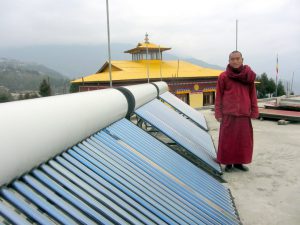Diálogo Chino: So much has changed over the past 18 months within the China, US and Latin America triangle that you describe in your new book. What has been the most significant event in this period?
Kevin Gallagher: The most significant event has been the shifting global economic context: The slowdown in the Chinese economy and the movement towards rising interest rates in the US. Those two points in the triangle have had the most significant change – that’s what has ushered in the new era of China-Latin America relations. It really started in 2013 but the past 18 months have really solidified that. Latin America was growing like hot cakes from 2000-2013 but the engines of that growth: free money from the US during low interest rates and increasing demand from China for commodities, have reversed. For the first time since the 1990s there’s been net negative capital flows to Latin America, meaning more money is going out of the region than going in.
DC: How has this slowing demand in China affected Latin American economies?
KG: From 2003 to 2013 Latin America experienced a commodity boom. While a lot of people were probably reading about the incredible growth miracle that happened during the same period in China, when it entered into the World Trade Organization and got integrated with the world economy, this also created a miracle in places like Africa and Latin America. The copper wire going into the electronics exports came from Chile and Peru, the iron and steel for the skyscrapers in the cities came from Brazil and Peru, the soybeans for Chinese whose incomes were increasing and who live on a soy-based diet came from Paraguay, Argentina and Brazil. As this demand for China’s great industrialisation made the countries rich, Latin America won the China lottery.
DC: But Latin America has found itself prioritising commodity exports before, while other regions industrialised, hasn’t it?
KG: Indeed. Latin America also won the lottery of the 19th century because during the industrial revolution, Latin America happened to have what the West needed. The West was moving off the farm and away from the mines and into the cities to have big industrialisation, and Latin America supplied the primary commodities for that and grew significantly in the same way. But Latin American countries have not realised how to diversify into other, cleaner sectors and also have failed to think about managing natural resources in a less intensive way that creates less social conflict, while still maintaining the ability to use these resources for economic gain.
DC: In your book you note the increasing awareness of the impacts of China’s trade and investment on Latin American environments. There is an argument that because of the high environmental costs at home, China now exports environmentally-sensitive industries overseas. How much credibility do you give that?
KG: China is over a billion people in a vast country with lots of natural resources, but it doesn’t have enough of those resources to feed and industrialise, nor does any other country in the world. China has to import and because they see Latin America as a strategic place for imports for many of these primary commodities that they can’t produce in a self-sufficient manner any more, they’re also investing in foreign countries, with FDI and bank loans, to further secure those lines. Primary commodities are endemically carbon-intensive and endemically highly-polluting. Yes, it’s China that happens to be the place where, at this point, the demand is, but is China exporting its environmental problems? China is just industrialising like the West did and neither the West nor China has come up with a clean and alternative path. South America and Mexico have higher levels of environmental standards on paper than the Chinese, they are just turning a blind eye to them in order to be able to export stuff to China.
China has really helped the world to reduce carbon emissions, pioneer new technologies and accelerate their diffusion better than we’ve seen in 50 years, but they’re not globalising their big domestic contributions. They’re globalising the things that are on the way out at home. For example, we’re seeing less and less coal plants in China. Latin America is stuck in a commodity-led growth mindset that was only accentuated by Chinese demand. A little too much blame goes to China and it’s too easy for Latin Americans to blame others for their environmental problems. It’s their copper, it’s their iron ore and as I say in the book, these economies need to use those as sources of growth to diversify into cleaner and more socially inclusive economic activity. That means protecting them.
DC: Is there a tendency in the US and in Europe to see the China-Latin America relationship in terms of the influence these Western powers have lost?
KG: American scholars and American policymakers really need to break out of the “G2” view of the world. This book is really drawing from years of on the ground fieldwork and collaborations with Latin American scholars, advocates and government officials in addition to collaboration with China to try to look at this from a Latin American development perspective. The US is hung-up on seeing Latin America as its backyard.
DC: How much of a motivating factor in Obama’s recent Cuba and Argentina visits was the growth in the relationship with China over the past decade?
KG: Hopefully China’s engagement within Latin America shifts US policy away from taking the region for granted. We gave the region very little attention but when we do give it attention, it’s been very patronising; telling someone how to run an election, telling them how to run their economy with no finance or commitment to back it. The Chinese don’t tell you how to run your economy and they leave a big bag of money behind. The US really needs to create a narrative of ‘partnering‘ with the Latin Americans, not being patronising towards them. There are a lot of things that brought Obama to Cuba – a lot of domestic politics around it – but the Obama administration would have done even more if it had its own way in this second term because they’re realising that to start a conversation about a real partnership, you have to say and do the right things, you have to reach out to Cuba and not call it a pariah. You can’t look at it through a US Cold War lens. China is part of the equation but it’s not the whole thing.
DC: In the post Washington Consensus era, what do you think the US has learned from China about not being seen to impose policy prescriptions on Latin American governments?
KG: China offers a different model of engagement, which is less policy advice and more cooperation. Obama has taken a couple of steps in the right direction on Latin America – on Cuba and immigration.
DC: There have been electoral setbacks for the progressive governments in Latin America, if a swing to the right is occurring, what implications could this have for institutions such as CELAC (the Community of Latin American and Caribbean States) which has been an important platform in advancing Chinese engagement with the region?
KG: Latin American governments both left and right have mismanaged the China-Latin America relationship and they’re deserving of pushback by their populaces. My concern of a rightward swing is that they won’t learn the lessons any more than the left didn’t. If their answer is to have a Washington Consensus view of it and not try to manage and work together with China as a region, then they’re going to make the problem worse. What the Chinese are about to learn is that in Latin American politics are a pendulum. They go far from far left to far right and they throw one model out and then create a new one.
China would be smart to engage with more permanent institutions in the region. CELAC has hardly any staffing and its backing by governments is now under question. It should create a tripartite engagement structure with the Chinese that includes CELAC, CEPAL and CAF, a bank that doesn’t have the US and Canada as a part of it. CEPAL has had great ideas on economic policy, on the environment and social inclusion and has not been swayed by the electoral tides in the region. If you could anchor CELAC with these more permanent bodies, you could have convening power to bring Latin Americans together regardless of what their political perspectives are. That’s the only way to have a region-wide strategy for their own development and a region-wide strategy with China, the US and the rest of the world.




![Hilsa fish at a market in Barisal, Bangladesh [image by Finn Thilsted]](https://dialogue.earth/content/uploads/2016/04/Hilsa-fish-bangladesh-pic-300x199.jpg)


